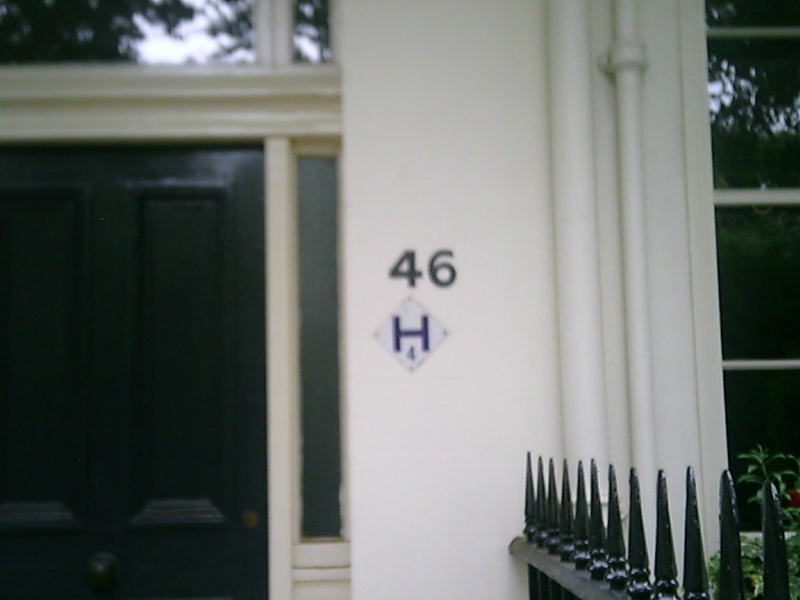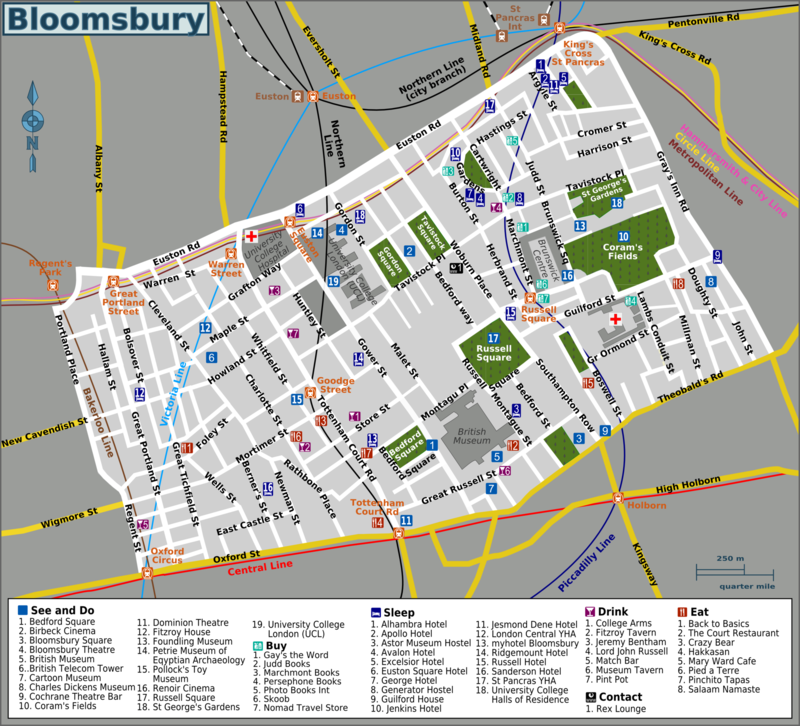THE BLOOMSBURY GROUP IN GORDON SQUARE (LONDON)
 Cette plaque commémorative au célèbre cercle des intellectuels de Bloomsbury Group est située au N° 50 de la rue Gordon Square. Cette dernière rue entoure le parc de Gordon Square où les membres du groupe venaient se détendre pour prolonger leurs discussions informelles. Il existe deux parcs, le parc de Bloomsbury Square qui déroute les visiteurs et le parc de Gordon Square. A l'entrée du parc de Gordon Square, il est écrit : "Welcome to Gordon Square Garden". L'université de Londres (UCL) a érigé un panneau explicatif du groupe de Bloomsbury Group intitulé "The Bloomsbury Group in Gordon Square".
Cette plaque commémorative au célèbre cercle des intellectuels de Bloomsbury Group est située au N° 50 de la rue Gordon Square. Cette dernière rue entoure le parc de Gordon Square où les membres du groupe venaient se détendre pour prolonger leurs discussions informelles. Il existe deux parcs, le parc de Bloomsbury Square qui déroute les visiteurs et le parc de Gordon Square. A l'entrée du parc de Gordon Square, il est écrit : "Welcome to Gordon Square Garden". L'université de Londres (UCL) a érigé un panneau explicatif du groupe de Bloomsbury Group intitulé "The Bloomsbury Group in Gordon Square".
Nous nous sommes rendu sur place le 24 aoüt 2015 et avions copié à la main le texte rédigé par l'université de Londres. Nous vous livrons ce texte tel quel :
The Bloomsbury Group in Gordon Square
(copyright, University of London)
From the 1840 s the social mix of Bloomsbury began to change, with professional people replacing the gentry. In 1940 the novelist Henry James described it as an « antiquated, ex-fashionable region ». Gordon Square became the focus of the Bloomsbury Group, an unstructured set of writers artists and intellectuals. The group first developed around the Stephen family, the painter Vanessa (Bell) her sister novelist and critic Virginia (Woolf), and their brothers Thoby and and Adrian, who moved into N° 46 Gordon Square in 1904 following the death of their father. They found the atmosphere of Bloomsbury refreshing after theirs previous home in conservative Kensington. The Stephens held regular thursday evening 'at homes' where they had literary and intellectual discussions with their friends, who included Lytton and James Strachey, Leonard Woolf George Bernard Shaw, Maynard Keynes, Clive Bell and EM Forster, many of whom had met Adrian and Thoby at Cambridge University. Vanessa and Virginia also began the Friday Club as a forum for artists, which included Duncan Grant Roger Fry and John Nash.
N° 46 Gordon Square was home to the Stephen siblings from 1904 – 1907. In 1907 Vanessa married art critic and writer Clive Bell and they took over N°46, living there until 1916. John Maynard Keynes leading economist and later Lord Keynes lived at N° 46 Gordon Square from 1916 – 1946 with his wife Lydia Lopokova, the Russian born ballerina. Virginia Stephen married Leonard Woolf in 1912 and they lived in near by Tavistock square.
In 1920 Vanessa Bell and her children moved to N° 50 Gordon Square, where her brother Adrian Stephen and her wife also lived. Clive Bell joined them in 1922, From 1925 Clive and Vanessa Bell lived at N° 39 Gordon Square with Duncan Grant. Duncan Grant's cousin Lytton Strachey a critic and biographer and leading member of the Bloomsbury group, lived at N°51 Gordon Square from sometime before 1919, the exact date is unknow.
The Strachy family were at the heart of the Bloomsbury Group and various members of the family lived at N° 41 Gordon Square from 1919-1956. They included Lytton's cousin, John St Loe Strachey proprietor and editor of the spectator, and Lytton's brother, James Strachey (psychoanalyst and author) who together with his wife Alix Sergent Florence translated Sigmund Freud's work into English. Dora Carrington artist and life long friend of Lytton Strachy also lived at N° 41 Gordon Square from 1920 to 1923. The social life of the circle revolved around the london and country houses of its various members and friends. The lifestyle of some of the set seemed outrageous to outsiders mainly because of their many love affairs with partners seeming to move from one person to another. The group continued until the 1940 s when it lost its cohesion following deaths of keys members. After the second world war Bloomsbury became less and less residential. Today most of the buildings in Gordon and Woburn Square, house academic activities of Colleges of the University.
Both Gordon Square and Woburn Square Gardens were restord in 2006 by the University of London with financial assistance from the National lottery through the heritage lottery fund, English Heritage and the Wolfson foundation.
The Wolfson – Foundation, 8 queen Anne Street London WIG 9LD. University of London.
Histoire de Bloomsbury Group.
Tout commence au 22 Hyde Park Gate selon Virginia Woolf : « 46 Gordon Square could never have meant what it did had not 22 Hyde Park preceded it (1) (Le 46 Gordon Square n'aurait jamais été ce qu'il a été si le 22 Hyde Park Gate ne l'avait précédé (2)» En notes infrapaginales, il est noté : « A la mort de Leslie Stephen, en 1904, les quatre Stephen quittèrent le 22 Hyde Park Gate pour le 46 Gordon Square à Bloomsbury ». Trois familles vivaient dans la maison du 22 Hyde Park, composées de dix-sept ou dix-huit personnes âgées de huit à soixante ans. Sir Leslie Stephen fut un critique littéraire et l'éditeur des 26 premiers volumes de The Dictionary of National Biography.Leslie Stephen s'était marié en première noce avec « Minny » Harriet. Ils eurent une fille, Laura en 1870 (3). A la mort de sa mère, cette enfant, handicapée mentale, fut internée dans un asile (asylum). Veuf (widower), Leslie Stephen épousa en seconde noce la veuve (widow) Julia en 1878. Cette dernière née en 1869 eut dans son premier mariage avec Herbert Duckworth trois enfants : George (1868), Stella (1869) et Gerald né en 1870 après la mort de son père. Le couple Stephen et Julia eut quatre enfants : Vanessa (née en 1879), Thoby (né en 1880), Virginia (née en 1882),Adrian (né en 1883). Le couple Stephen – Julia fut donc une famille recomposée avec huit enfants. Virginia Stephen passa ses 22 ans au 22 Hyde Park. Madame Julia mourut la première ; suivi de son mari Leslie Stephen. Les enfants du premier mariage de Julia quittèrent le 22 Hyde Park. Les quatre enfants du deuxième mariage de Julia se retrouvèrent seuls au 22 Hyde Park. C'est pendant sa dépression où Virginia Stephen fit sa première tentative de suicide, que sa soeur Vanessa Stephen avait vendu la maison du 22 Hyde Park. Elle avait choisi d'aménager avec sa soeur et ses deux frères au 46 Gordon Square WC1, rue entourant le parc de Gordon Square, en plein coeur de l'université de Londres (University College of London). Virginia Stephen y a vécu de janvier 1905 à mars 1907. Quant à l'économiste JOHN MAYNARD KEYNES (1883-1946) il y a vécu pendant 30 ans de 1916 à 1946.
On peut donc délimiter le quartier de Bloomsbury au Nord-Ouest du Centre de Londres de deux façons. Dans un espace interne inclus dans un fermé, dont les éléments sont bien déterminés, en recensant les librairies répertoriées dans Bloomsbury par les rues suivantes :
- à l'est, la rue Gray's Inn Road dont la librairie de référence est The connection Association, 244 Gray's Inn Road ;
- à l'ouest, la rue Tottenham Court Road prolongée par Charing Cross Road dont la librairie de référence est Claire de Rouen Books, 121-125 Charing Cross Road ou Soho Original Books à la même adresse ;
- au nord, la rue Euston road ;
- au sud la rue High Holborn dont la librairie de référence est Blackwell's au 50-51 High Holborn.
C'est dans ce quartier que l'élite intellectuelle de l'Angleterre du 20e siècle a vécu et pensé le monde. En mathématiques Bertran Russell (1872-1970) et A.N. Whitehead rédigèrent The principles of Mathematics (1903) ; en économie, John Maynard Keynes (1883-1946) avec The economics consequences of the peace (1919). L'écrivain Charles Dickens né en 1812 a vécu au 48 Doughty Street où il a écrit Oliver Twist est inclus dans Bloomsbury frontalier quartier Clerkenwell.
Voici la géographie de Bloomsburry éditée par Wikipedia : "Bloomsbury has no official boundaries, but can be roughly defined as the square of territory bounded by Tottenham Court Road to the west, Euston Road to the north, Gray's Inn Road to the east, and either High Holborn or the thoroughfare formed by New Oxford Street, Bloomsbury Way and Theobalds Road to the south.[2] Bloomsbury merges gradually with Holborn in the south, with St Pancras and King's Cross in the north-east and with Clerkenwell in the south-east".Elle est équivalente à notre trouvaille. Puisque nous étions sur place.
De façon externe, en recensant les librairies exclues de Bloomsbury, donc les quartiers entourant Bloomsbury, sont Euston, Fitzrovia, King's Cross, Covern Garden et Clerkenwell.
Références. (1).Virginia Woolf, Moments of Being, Londres, Pimlico, 2002, p. 44.
(2).Virginia Woolf, Instants de vie, Paris, Stock, 1986, p. 222.
(3). Jean Moorcroft Wilson, Virginia Woolf's London, , London, TPP, 2000, p. 20-21.









/https%3A%2F%2Fassets.over-blog.com%2Ft%2Fcedistic%2Fcamera.png)
/https%3A%2F%2Fi1.wp.com%2Frp221.com%2Fwp-content%2Fuploads%2F2020%2F06%2FSOULEYMANE-BACHIR-DIAGNE.png%3Ffit%3D750%2C575%26ssl%3D1)
/https%3A%2F%2Fi2.wp.com%2Fcongo-liberty.com%2Fwp-content%2Fuploads%2F2019%2F07%2Fcdaff8eb62b3461e68d0095c1378e333_2.jpg%3Fw%3D640)